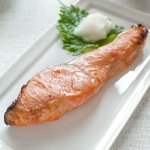
At the end of the instructions, I also added how to cook salted salmon fillets. So Prep Time is to make salted salmon, Cook Time is to cook salmon.
- 350g (0.8lb) x2 salmon cutlets (steaks) to make 150g (0.3lb) x4 fillets (note 1)
- 20g (0.7oz) salt (normal salt, about 3-4% of salmon weight, note 2)
-
Remove the bone from each cutlet to make two fillets (Refer to Japanese Salmon Mirin-zuke to see how it is done).
-
Rinse the salmon fillets under cold water and pat dry with paper towel.
-
Sprinkle salt over the both sides of each fillet. Try to put more salt on the skin.
-
Line an airtight container or a tray with two layers of paper towel and place the salted fillets without overlapping on the paper towel.
-
Cover the surface of the fillets with two more layers of paper towel, tucking in the edges so that the fillets are wrapped in the paper towels completely and firmly.
-
Place the lid on airtight container or cover the tray with a sheet of cling wrap. Leave the container/tray in the fridge for 2 days.
-
If the surface of the fillets is wet, wipe excess moisture with paper towel. Now it is ready to broil, grill or freeze.
-
Adjust the rack so that the distance between the heat and the fish is about 10cm (4”).
-
If you have a metal grid with a tray, heat it under the broiler. Otherwise, preheat the broiler and also line a baking tray with a piece of scrunched aluminium foil (note 3).
-
Place salted salmon fillets on the grid or scrunched aluminium (note 4) and place the tray under the broiler. Leave the oven door open to avoid the fish being steamed.
-
Cook for about 3 minutes until the edges of the fillets start browning. Turn them over and cook further 2-3 minutes. (note 5)
-
Heat the griller with a small amount of oil over medium high heat.
-
Place the salmon fillets (note 4) and cook for about 2-3 minutes. Turn them over and cook further 2 minutes or so. (note 5)
-
After wiping the moisture away with paper towel, wrap each fillet tightly with cling wrap and freeze them straight away.
-
Cook after defrosting. To defrost, leave them in fridge to thaw slowly.
1. I used salmon cutlets because the shape of the salmon pieces made from a cutlet is similar to those you get in Japan. This will make 4 fillets of about 150g (5.3oz) each. But if you prefer, you can use salmon fillets instead.
2. The amount of salt required to make salted salmon is between 3-7% of the total weight of salmon to be salted. Japanese recipes tend to use about 5% salt, but I found that it was too salty for my liking. So, I used 3%+ of salt: 3% of 600g (1.3lb) salmon = 18g (0.6oz).
If you prefer a saltier flavour, you can increase the amount of salt, but I would recommend starting with 3-4%. And if you think more salt is required, you can increase the salt next time when you make it. If salmon is too salty, it's not good to eat but if there is not enough salt, you can always sprinkle on a bit of salt or soy sauce when eating.
The more salt you use, the better the salted salmon preserves.
3. Cut a large piece of aluminium foil, twice as long as the width of the tray. Gently scrunch the foil to just fit in the tray. This will prevent the fillets from sticking to the bottom of the tray.
4. When cooking salmon fillets with one side covered with skin, place the skin side down first if you are serving the salmon with crispy skin side up. Otherwise, cook the skin side first.
5. The time required to cook the salmon through depends on the thickness of the fillet. My salmon was 2cm thick.